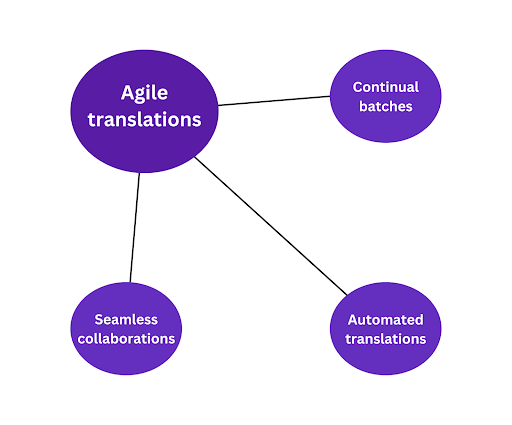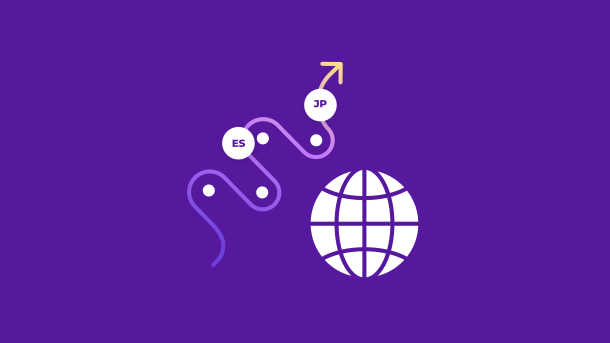You might already practice agile business. Sales teams use agile processes to close more deals. Marketers apply them to produce more campaigns. Agile processes work, and that’s why so many different teams and departments take advantage of them.
So why don’t businesses use agile solutions for localization? Agile methods produce results more quickly and evolve with fast-moving economic landscapes, making them ideal for enhancing localization strategies.
In this guide, we’ll define what business agility looks like for localization and its benefits. Then, we’ll explore how you can adopt agile solutions to maximize your strategy.
Defining agile translation
Agile translation is when teams iterate more frequently and quickly on translations. The focus is to get to market faster, improve collaboration, reduce risks, and increase return on investment.
The agile localization method follows these principles:

The image above emphasizes how agile translations require key principles for success.
1. Translate continuously in smaller batches
Localization produces experiences that feel native to users in different markets. It turns global strategies into something intimate; our approach to translations should look the same.
With agile translation methods, businesses can get rid of giant spreadsheets and quarterly multilingual website updates. Instead, their translation process includes a faster small-batch pipeline.
Companies can provide better-quality, more up-to-date translated content through continuous localization.
2. Simplify and automate workflows for content delivery
Localization through continuous processes sounds good in theory, but how can you actualize it? Agile localization requires technology that can streamline your workflow.
Smartling’s solutions combine automation, artificial intelligence, and translation services to create a centralized, end-to-end translation management software. You can manage your translation program easily within the translation management system (TMS), translate millions of words with integrated AI machine translation features, and maintain your brand voice and terminology with linguistic assets.
3. Implement agile collaboration for changing needs
Translation teams must manage review processes, collaborate and make expert adjustments where needed, and organize an entire content flow for translation. The most efficient solution for fast-moving localization is implementing agile processes.
How does agile translation work?
First, start by preparing for translations. Invest in internationalization by setting up your infrastructure for effective localization.
Review your tools, website structure, design, and publishing capability to manage and host a localization experience for all targeted customers.
Then, adopt a process that focuses on small sprint translation cycles (instead of larger, more spread-out cycles). This gets rid of many content gaps with expired information and brand experiences. Additionally, translators can focus more on quality with smaller groups of source text.
The small sprint process makes it easy to adjust and change content. Teams can take advantage of the rapid integration of observed results and tackle areas for improvement faster.
You can then work together to develop a collaborative approach. Connect in the same workspace, whether you are a translator, editor, reviewer, or other stakeholder.
Companies should review three phases to prepare for agile translation:
- Implement automation and consider utilizing AI translations
- Establish a system for collaboration
- Adopt a culture for market agility
Benefits of adopting an agile approach
In a global economy, many brands need to prepare for the market quickly. As a result, they’re looking to connect with a local audience and keep up with the fast-paced need for content and communication.
Agile solutions flip this script and create a dynamic, local approach that connects with customers. Companies can expect immediate advantages when they adopt an agile strategy for localization.
Here are just a few benefits of adopting an agile approach:
1. Decrease your time to market
Agile translations use AI-enabled human technologies to accelerate content delivery (all while increasing quality by up to 350% with tools like Smartling). Customers worldwide receive crafted translations with high accuracy at a fraction of the time traditional approaches take.
Thanks to technologies to assist linguists, like translation memory, translators don’t have to repeat translations for the same or similar content. AI recognizes similar source text and translates it based on your preferences.
Not only can you localize your initial content, but with a TMS, you can also ensure that new and updated content gets to market quickly through predetermined dynamic workflows.
2. Save time and shift resources
You’ll save considerable time thanks to machine translation and a more optimized pipeline. Localization teams can shift the time and resources they’d previously used toward higher-impact projects or strategizing on entering more markets. Team members can also create additional content and campaigns to expand their reach with current audiences.
The significant advantages of localization are company expansion and connecting with new audiences. And the more time you localize and expand, the more efficient you get—and the more exponential growth you can expect.
3. Connect with customers like a native brand would
Ultimately, at least to the customer, great localization shouldn’t feel like localization. Your brand should seem familiar and personal—like it belongs. Three challenges get in the way: speed, quality, and cultural relevance. The agile process conquers these challenges through the right technologies and native expert translators.
Localization is successful once brands can efficiently connect with audiences and increase sales. Companies can then continue to publish content and improve the process while expanding into more multilingual regions.
These are only a few benefits gained from adopting agile methods for localization. We’ll show you a real-life example to see how it can make a difference for you.
Challenges and solutions in agile translation
We’ve covered the essential steps for transitioning to agile processes. However, agility requires a clear action: finding a platform that can provide the tools for automation, machine translation, management, and human collaboration.
Without the right solution, it’s impossible to offer an agile solution that scales. You would need a massive team juggling dozens of translation tools for the initial localization. And that’s just getting started; keeping up with new content and updates is another giant task.
But when companies adopt an agile translation solution, their localization strategy moves into hyperdrive.
Their workflow becomes a seamless integration of language translation into the site, app, or product development process. Instead of translation after development, bare-bones translations (like date format, currency, and images) happen alongside development.
These advantages can be achieved with a partner that provides cutting-edge technologies leveraging AI and automation.
Smartling, the premier agile translation solution, uses both AI-enabled machine translation and human translators to provide an immediate, accurate way to translate content as development continues—and forever.
Embrace agile translation with Smartling
Smartling’s TMS offers the foundation and tools for a successful agile translation strategy.
The TMS technology and Smartling’s innovative tech stack and human experts continue to produce an advantage for companies worldwide. We call it the Smartling advantage. Clients experience these types of results:
- 90% better on-time delivery
- 42% faster time to market
- 48% fewer changes requested
- 30% reduction in translation costs
You can reach new markets and provide the perfect brand experience—the same one your native audience gets. And you can accomplish this while delivering faster, better-quality translations.
Watch a brief demo today to see how you can scale worldwide through agile solutions.






